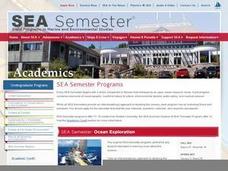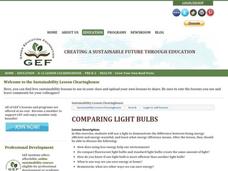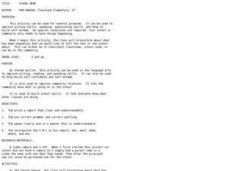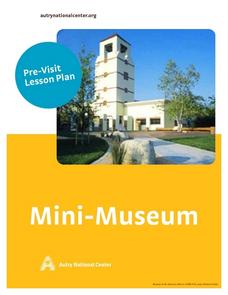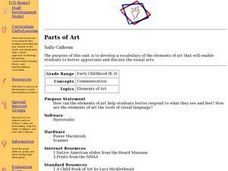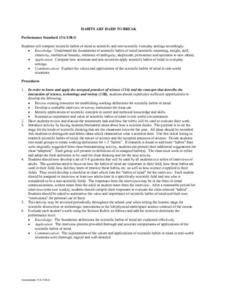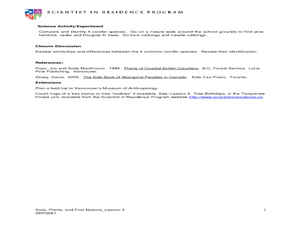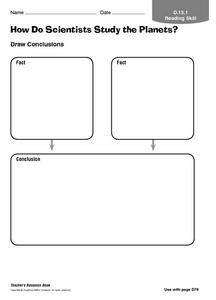Curated OER
Creature From The Deep
Students become familiar with oceanography terms by writing an oceanography horror story.
Curated OER
Where is Shirley the Elephant?
Young animal lovers engage in a instructional activity that's all about elephants. They access an elephant sanctuary website and read a story about Shirley the elephant. They perform a series of activities based upon that story, and also...
Curated OER
Pollution
Young ecologists investigate some of the many ways that human activities adversely affect the environment. After identifying the main types of pollution (air, water, soil), 3rd graders fill in a Venn Diagram by pasting cut-out pictures...
Curated OER
Sand Travels
Learners examine how sand is formed by erosion and that it can be moved by streams, rivers, and ocean currents in this unit of lessons. They study waves and currents, and structures that change how sand moves by creating story charts,...
Curated OER
Sustainable Development
Young environmentalists use a conference format to reach consensus on ways to slow deforestation and promote sustainable development. Class members are assigned roles to play during the conference, and work on posters and a public...
Curated OER
Prehistoric Pen Pals
Young scholars read online information and identify relevant information about a particular dinosaur species, assume the personality of a specific dinosaur species, and write online "getting to know you" letters to other...
Curated OER
Building A Solar Still
Students investigate the water cycle by viewing an online video. In this drinking water lesson, students create solar stills at their campus in order to purify water that is tainted. Students view a video on their computers...
Curated OER
Comparing Light Bulbs
Third graders learn how light bulbs are different and which are more cost efficient. In this energy and efficiency lesson, 3rd graders compare the cost of a light bulb and understand that its lifetime is important to their...
Scholastic
STEM Challenges and Activity Sheets 3–5
How can engineers help their communities? Three challenges in the first unit explore why STEM is important to communities and how neighborhoods are engineered to experience those benefits. The second unit prompts groups to plan an...
Curated OER
Creature Feature Poetry Keyword Search!
Young scholars examine the differences between fact and opinion, and brainstorm ideas for a keyword list by analyzing facts. They listen to poems, and create posters listing three keywords about each creature featured in the poetry.
Curated OER
School News
Compile a school newsletter with your budding journalists! Use the school calendar to assign each learner a specific even to cover! Possible events include the science fair, sports games, concerts, talent shows, etc. This is a project...
Curated OER
Mini Museum
Students brainstorm about the different types of museums and complete a worksheet by looking at artifacts and what they think that object did. They work together in groups to complete a KWL chart throughout the instructional activity.
Curated OER
Parts of Art
Young scholars define and use new vocabulary associated with the elements of art. As a class, they brainstorm different ways in which we communicate with one another. In groups, they view different pieces of art from the Native American...
Curated OER
Idea Wheel
In this graphic organizer worksheet, student label four sections of a circle. Students write or draw ideas in each section. This idea web can be used for primary grades because it includes illustrations.
Curated OER
Habits Are Hard to Break
Studens brainstorm ideas about the ways scientists think. In small groups, studentds create a definition for one or two "habits." Students develop a set of questions to be used by the entire class in a series of interviews. Students...
Curated OER
Bird Beak Anatomy
Third graders participate in an activity to determine which tool will work the best to gather food. They create analogies about how the experiment relates to birds. They brainstorm about which adaptation helps or hurts the survival of an...
Curated OER
Western Red Cedar
Young scholars explore the First Nations uses of the Western Cedar tree. In this nature activity students compare and identify four conifer species. The young scholars go on a nature walk.
Curated OER
What Do Animals Eat?
In this animal diet worksheet, students will brainstorm what animals eat and write it down in a graphic organizer. Then students will brainstorm what people should eat and write it down.
Curated OER
How Do Scientists Study the Planets?
In this planets worksheet, students brainstorm 2 facts about how scientists study the planets. Then students will come to a conclusion based on their facts. This worksheet is a graphic organizer.
Curated OER
Uses of Natural Resources
For this natural resource worksheet, students will brainstorm examples of how natural resources are used. Students will fill in three questions concerning air, soil, and water.
Curated OER
Uses for Natural Resources
In this natural resources worksheet, students will brainstorm different uses for air and water resources. Students will fill in four answers in a graphic organizer.
Curated OER
How Do Scientists Use Telescopes?
In this astronomy worksheet, students will brainstorm problems that scientists might face when studying objects that are far away and then students will come up with a solution for that problem.
Curated OER
How Do Living Things Compete?
In this living things worksheet, students will brainstorm and fill in a graphic organizer focusing on the main idea of how living things compete. Then students will add four details to support their main idea.
Curated OER
Traits of Living Things
In this characteristics of living things worksheet, students will brainstorm five traits of living things and fill in a graphic organizer.
